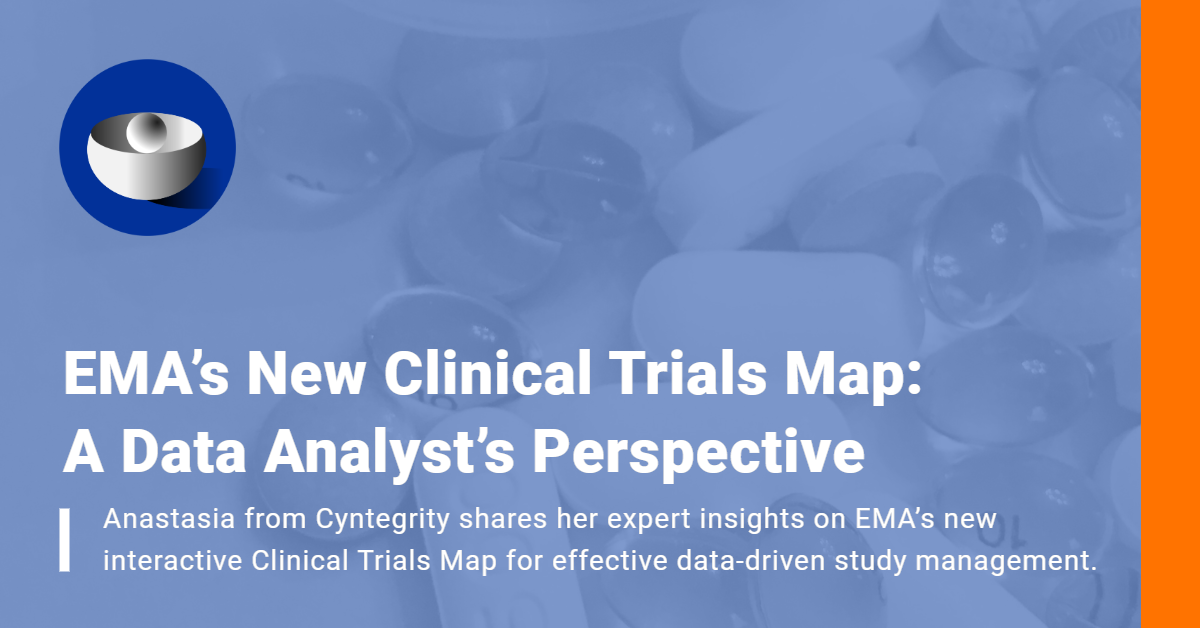[Scroll down to download your free step-by-step guide on Centralized Monitoring.]
A Quick Recap – What is Centralized Monitoring?
For quite some time now, Centralized Monitoring has been acclaimed as the most suitable and cost-effective approach to achieve a higher level of data quality and enhanced oversight of patient safety by the key European and American regulatory agencies; FDA, EMA, and MHRA. Since the release of their GCP guidance documents in 2011-2013, the agencies have been encouraging clinical researchers to adopt a risk-based approach to monitoring. In this light, the guidance proposes Centralized Monitoring as one of the critical components of modern Risk-based Quality Management (RBQM) strategies in clinical research.
Digitalization More Than Just “Going Paperless”
The 2016 ICH E6 GCP guidance update subsequently suggests new, digital opportunities recommending the use of electronic data recording and reporting technologies for the facilitation of clinical trials:
“Centralized monitoring can now offer a greater advantage, to a broader range of trials”, according to the ICH E6 GCP (R2).
Yet, “digitalization” doesn’t simply mean converting paper records to electronic ones. The process of digitalization incorporates the adoption of a fundamentally new approach which leverages value adding technology and capabilities.
Both the FDA and EMA have already adopted the new ICH E6 (R2) guidance and it is anticipated that Japan (PMDA) will follow in the near future as well.
What Guidance Expects Us To Do
With regards to the purpose and preferred approach to centralized monitoring, the ICH E6 (R2) guidance document states the following:
Centralized monitoring is a remote evaluation of accumulating data, performed in a timely manner, supported by appropriately qualified and trained persons (e.g., data managers, biostatisticians).
Centralized monitoring processes provide additional monitoring capabilities that can complement and reduce the extent and/or frequency of on-site monitoring and help distinguish between reliable data and potentially unreliable data.
Review, that may include statistical analyses of accumulating data from centralized monitoring can be used to:

-
- identify missing data, inconsistent data, data outliers, unexpected lack of variability and protocol deviations.
- examine data trends such as the range, consistency, and variability of data within and across sites.
- evaluate for systematic or significant errors in data collection and reporting at a site or across sites, or potential data manipulation or data integrity problems.
- analyze site characteristics and performance metrics.
- select sites and/or processes for targeted on-site monitoring. [1]
The FDA guidance for industry (2013) places even greater emphasis on centralized monitoring than ICH E6 (R2). The guidance specifically encourages greater use of centralized monitoring methods where appropriate ensuring the quality of clinical trial data. The FDA believes that centralized monitoring can identify almost 90% of on-site monitoring findings and provide additional capabilities.
A Peek Inside the Centralized Monitoring Toolbox
The available tools for centralized monitoring include Centralized Statistical Monitoring (CSM), Key Risk Indicators and Quality Tolerance Limits, and of course informative data visualization:

Applying Centralized Monitoring Techniques
Centralized monitoring techniques are recommended to be used to the extent feasible and appropriate:
- Supplement or reduce the frequency and extent of on-site monitoring with monitoring activities that can be done as well or better remotely or with monitoring activities that can be accomplished using centralized processes only. Examples include:
- Monitor data quality through routine review of submitted data to identify and follow-up on missing data, inconsistent data, data outliers, and potential protocol deviations that may be indicative of systemic or significant errors in data collection and reporting at a site
- Conduct statistical analyses to identify data trends not easily detected by onsite monitoring, such as
- Standard checks of range, consistency, and completeness of data
- Checks for unusual distribution of data within and between study sites, such as too little variance
- Analyze site characteristics, performance metrics (e.g., high screen failure, lost to follow-up or withdrawal rates, high frequency of eligibility violations, delays in reporting data), and clinical data to identify trial sites with characteristics correlated with poor performance or noncompliance
- Verify critical source data remotely as described in the monitoring plan, in cases where such source data are accessible, or where CRF data are, according to the protocol, source data
- Complete administrative and regulatory tasks. Such tasks include, for example, verifying continuous institutional review board (IRB) approval by reviewing electronic IRB correspondence, if available; performing portions of investigational product accountability, such as comparison of randomization and CRF data, to preliminarily assess whether the subject was administered or dispensed the assigned product and to evaluate consistency between investigational product receipt, use, and disposition records; and verifying whether previously requested CRF corrections were made.
Additional Insights Provided by Centralized Monitoring
Centralized monitoring techniques, including routine review of submitted data and statistical and other analyses, may also be used to identify significant concerns (e.g. need for clarification of a protocol procedure, indications of data fabrication) with non-critical data that may not have otherwise been a focus of monitoring (e.g. source document verification).
- Target on-site monitoring by identifying higher risk clinical sites (e.g., sites with data anomalies or a higher frequency of errors, protocol violations, or dropouts relative to other sites), through the activities described above. Such findings, whether related to critical or non-critical data, may warrant more intensive and consideration of on-site monitoring.[2]
A joined guidance of the United Kingdom Department of Health (DH), Medical Research Council (MRC) and Medicines and Healthcare products Regulatory Agency (MHRA) also calls for using centralized monitoring in clinical trials enabling to make:
- Eligibility checks prior to randomization
- Rates of recruitment, withdrawals, and losses to follow-up by site
- Checks for missing or invalid data (range and consistency checks)
- Checks that dose adjustments, investigation, and management of events are consistent with the protocol
- Calendar checks
- Checks for unusual data patterns
- Assessment of adverse events and toxicity reporting rates
- CRFs completed by authorized persons
- External verification (with participant consent) of events (e.g. birth, disease, and death registries)[3].
A Key Element of the Quality System
The EMA guidance document “Reflection paper on risk-based quality management in clinical trials” (2013) recommends implementing central monitoring as a “key element of the quality system” and describes it as:
Document review, data review, and analysis performed remotely from the investigator site by the sponsor to examine the data collected in order to check compliance, identify unusual data patterns, deviations from protocol or missing or invalid data. Examples of central monitoring techniques include checks of submitted documents (e.g. checklists for TMF content completed by investigators, training evidence etc.), clinical data checks (e.g. range checks, calendar checks etc., rate of reporting adverse events), compliance data/metrics checks (e.g. number of reported deviations from the protocol, rate of reporting adverse events… etc.)[4].
Summing-up, it is clear that the EU and US regulatory authorities unanimously consider centralized monitoring as a key component of risk-based quality management in clinical trials – a highly recommended approach for clinical trial conduct in today’s digital world.
We summarized Centralized Monitoring the infographic way, get your free PDF copy here:
References
- [1] International Council for Harmonization of Technical Requirements for Pharmaceuticals for Human Use (ICH). ICH HARMONISED GUIDELINE – INTEGRATED ADDENDUM TO ICH E6(R1): GUIDELINE FOR GOOD CLINICAL PRACTICE E6(R2). Current Step 4 version dated 9 November 2016. Available at: https://www.ich.org/fileadmin/Public_Web_Site/ICH_Products/Guidelines/Efficacy/E6/E6_R2__Step_4_2016_1109.pdf Accessed 19 March 2019
- [2] US Food and Drug Administration Guidance: Oversight of Clinical Investigations – A Risk-Based Approach to Monitoring. Available at: http://www.fda.gov/downloads/Drugs/./Guidances/UCM269919.pdf Accessed 19 March 2019
- [3] UK Medicines and Healthcare Products Regulatory Agency (MHRA) Risk-adapted Approaches to the Management of Clinical Trials of Investigational Medicinal Products (2011). Available at: https://www.gov.uk/government/uploads/system/uploads/attachment_data/file/343677/Risk-adapted_approaches_to_the_management_of_clinical_trials_of_investigational_medicinal_products.pdf Accessed 19 March 2019
- [4] European Medicines Agency – Reflection Paper on Risk-Based Quality Management in Clinical Trials (2013): http://www.ema.europa.eu/docs/en_GB/document_library/Scientific_guideline/2013/11/WC500155491.pdf Accessed 19 March 2019
NEW | The Clinical Researcher’s Guide to RBQM
Discover the future of clinical research with “The Clinical Researcher’s Guide to RBQM” by Artem Andrianov, PhD, and Johann Proeve, PhD.
This comprehensive guide (160+ pages Kindle edition) explores the principles of risk-based quality management, offering invaluable insights for optimizing clinical trials. Don’t miss your chance to be at the forefront of innovation in biopharmaceutical product development.







